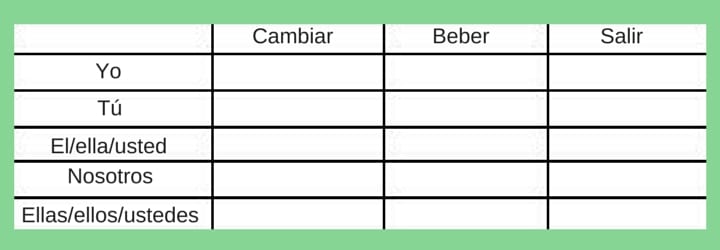What do you know about future and conditional tense Spanish? Spanish learners should know how to conjugate these tenses so you can talk about upcoming events! Spanish tutor Jason N. teaches you here…
Are you curious about the conditional tense Spanish? This will tell you everything you need to know about the common verb tense.
Conjugation is one of the most fundamental parts of learning Spanish. As we get to this last post on conjugation, you will already have a nice base for patterns and formulas. This post is the grand finale, part V of my series about conjugating verbs in Spanish.
By now, you have come a long way. Remember, this learning is best taught chronologically, so before you tackle this post you should review the previous posts:
- How to conjugate basic Spanish verbs (present tense)
- How to conjugate stem-changing verbs in present tense
- Conjugating Spanish verbs in past tense
- How to conjugate the imperfect tense
This particular post is about the future tense Spanish and the conditional tense in Spanish but of course, it’s not the only tense you need to be aware of when you are learning how to speak Spanish.
What Are the 7 Tenses in Spanish?
When learning any language, you need to learn the basic verb tenses early on if you are going to be successful. There are many beyond this but the 7 tenses in Spanish that you should master are:
- Present simple tense
- Past preterite tense
- Past imperfect tense
- Future inflection
- Conditional tense
- Present subjunctive
- Past subjunctive
You can view more information about Spanish verb tenses in this video:
What is the Spanish Conditional Tense?
The conditional tense Spanish describes what you would like to do given certain conditions, and the future tense describes events that will happen in the future.
3 Types of Conditional Tense Spanish
There are three main types of conditional tenses in Spanish. These include the simple conditional tense, the conditional perfect tense Spanish, and the continuous conditional tense.
The simple conditional is the most common – it’s easy to make a Spanish sentence conditional simply by thinking of the English formula “would + verb.”
The perfect conditional can be used to make a conjecture about the past when we say what might have happened if the conditions had been more favorable. Use the formula “would have + past participle” for this.
Finally, the continuous conditional will show you an action that will be in progress at a certain moment of time. It can also express some sort of speculation about what might be happening. Use the formula “would be + gerund (-ing verb).”
What is the Conditional Tense Example?
Here are some conditional tense Spanish examples to help you make sense of it all.
The following sentences would use the conditional tense:
- I would go to the game. (Iría al partido)
- They would see the movie. (Verían la película)
Alternately, these sentences would use the future tense:
- I will go to the game. (Iré al partido)
- They will see the movie. (Verán la película)
Identical to others tenses, the Spanish conditional and future tenses break down verbs into five different ending variants. By now you have probably mastered how it works. All we need to do now is learn another new formula.
The conditional tense is strikingly similar to the imperfect. The key difference is that in the conditional tense, we don’t shave off the -ar, -ir, or -er verb ending first — but the conjugation ending is the same! As we have used the example of the verb mirar (to watch) in the previous articles, let’s continue with that.
Here’s a helpful video to give you more information on how to conjugate these Spanish future tense conjugation verbs:
How to Conjugate -ar Verbs in Conditional Spanish Tense
If you need to know how to use conditional conjugation –ar verbs, these guidelines should help.
– DON’T shave off the ending -ar; leave it alone!
– If you are referring to ‘yo’ or ‘I,’ add the ending ‘ía’ to end the infinitive verb, forming miraría.
– When you are referring to ‘tú’ or ‘you,’ add the ending ‘ía,’ to form mirarías.
– If you are referring to ‘él’ or ‘ella” or ‘he or she,’ use the ending ‘ía’ to form miraría*.
*Yes this is the same as the ‘yo’ form, just like the imperfect!
– If you are referring to ‘nosotros’ or ‘we,’ use the ending ‘íamos’ to form miraríamos.
– If you are referring to ‘ellos’ or ‘they,’ use the ending ‘ían,’ to form mirarían.
What about -er verbs? Let’s use comer (to eat) as an example again:
How to Conjugate -er Verbs in Conditional Tense
Here are some tips for conjugating -er verbs in the Spanish conditional tense.
– DON’T shave off the ending -er
– Same as -ar verbs to form comería.
– Same as -ar verbs to form comerías.
-If you are referring to ‘él’ or ‘ella” or ‘he or she,’ same as -ar verbs to form comería*.
*Yes this is the same as the ‘yo’ form as well!
-If you are referring to ‘nosotros’ or ‘we,’ Same as -ar verbs to form comeríamos.
-If you are referring to ‘ellos’ or ‘they,’ same as -ar verbs to form comerían.
How to Conjugate -ir Verbs in Conditional Tense
Here are some tips for conjugating -ir verbs in conditional tense.
Same rules as with -ar and -er verbs
See the following charts of key conditional tense verb conjugations:
Mirar (to watch):
Yo miraría
Él/Ella/Usted miraría
Nosotros miraríamos
Ellas/Ellos/Ustedes mirarían
Comer (to eat):
Yo comería
Tú comerías
Él/Ella/Usted comería
Nosotros comeríamos
Ellas/Ellos/Ustedes comerían
Vivir (to live):
Yo viviría
Tú vivirías
Él/Ella/Usted viviría
Nosotros viviríamos
Ellas/Ellos/Ustedes vivirían
Ready for some practice? Conjugate the following conditional tense Spanish words:
After all, the best way to learn is to do some repetitive conditional tense Spanish practice!
Moving on, the future tense in Spanish does have many irregulars but in this post I just wanted to you get the basic idea. The future tense is similar to the conditional in that you add the ending to the given verb in its infinitive form. Let’s continue with mirar:
How to Conjugate -ar Verbs in the Future Tense
Here are some guidelines for conjugating –ar verbs in the future tense.
– DON’T shave off the ending -ar; leave it alone!
– If you are referring to ‘yo’ or ‘I,’ add the ending ‘é’ to end the infinitive verb, forming miraré.
– If you are referring to ‘tú’ or ‘you,’ add the ending ‘ás,’ to form mirarás.
– When you are referring to ‘él’ or ‘ella” or ‘he or she,’ use the ending ‘á’ to form mirará.
– If you are referring to ‘nosotros’ or ‘we,’ use the ending ‘emos’ to form miraremos.
– If you are referring to ‘ellos’ or ‘they,’ use the ending ‘án,’ to form mirarán.
What about ER verbs? Let’s use comer (to eat), for example:
How to Conjugate -er Verbs in the Future Tense
If you need to know how to conjugate -er verbs in the future tense, these tips will help.
– DON’T shave off the ending -er
-Same as -ar verbs to form comeré.
-Same as -ar verbs to form comerás.
-If you are referring to ‘él’ or ‘ella” or ‘he or she,’ same as -ar verbs to form comerá.
-When you are referring to ‘nosotros’ or ‘we,’ same as -ar verbs to form comeremos.
-If you are referring to ‘ellos’ or ‘they,’ same as -ar verbs to form comerán.
How to Conjugate -ir Verbs in the Future Tense
Next, here are some tips to help you conjugate -ir verbs in the future tense.
Same rules as with -ar and -er verbs
See the following examples of key Future verb conjugations:
Mirar:
Yo miraré
Tú mirarás
Él/Ella/Usted mirará
Nosotros miraremos
Ellas/Ellos/Ustedes miraránComer:
Yo comeré
Tú comerás
Él/Ella/Usted comerá
Nosotros comeremos
Ellas/Ellos/Ustedes comeránVivir:
Yo viviré
Tú vivirás
Él/Ella/Usted vivirá
Nosotros viviremos
Ellas/Ellos/Ustedes vivirán
Ready for some practice? Conjugate the following in the future tense:
The good news is that the future and conditional tenses have the same irregulars! While I won’t go into a lot detail here about the irregulars, here’s some common ones in which their stem changes:
Poner → Pondr forming Pondré instead of Poneré in its future ‘yo’ form
Salir → Saldr forming Saldré instead of Saliré in its future ‘yo’ form
Conditional Tense Spanish- Easier to Master Than You Think!
Hopefully, all these Spanish conditional tense endings and examples of the conditional future tense Spanish don’t have your head spinning! There’s a lot to master when it comes to learning Spanish, but fortunately, it’s easier than you might think.
Keep practicing and sign up for as many Spanish lessons as you can. Practice makes perfect, after all!
Need even more help? Contact your Spanish tutor with more questions about irregular conditional and future tense conjugations!
 Post Author: Jason N.
Post Author: Jason N.Jason N. tutors in English and Spanish in Fairfax, CA. He majored in Spanish at UC Davis, lived in Mexico for 3 years where he completed a Master’s degree in Counseling, and studied Spanish Literature and Psychology at the University of Costa Rica. Learn more about Jason here!
Suzy S.




